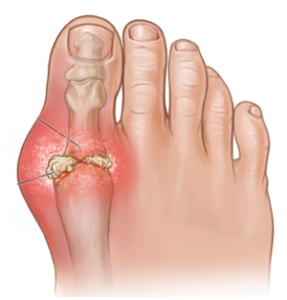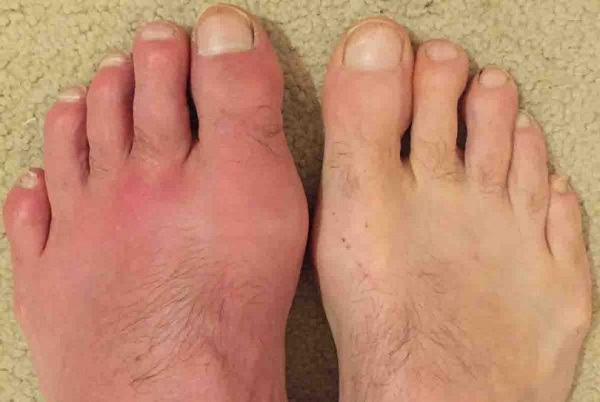Gout is a form of acute arthritis that causes severe pain and swelling in the joints. It most commonly affects the big toe, but may also affect the heel, ankle, hand, wrist, or elbow, rarely affects the spine. Gout usually comes on suddenly, goes away after 5-10 days, and can keep recurring. Gout is different from other forms of arthritis because it occurs when there are high levels of uric acid circulating in the blood, which can cause urate crystals to settle in the tissues of the joints. Men are more likely to get gout, but women become increasingly susceptible to gout after menopause. It is also called “gouty arthritis”.

Causative factors for gout:
Uric acid is normally cleaned out of the blood by the kidneys, and passes out of the body along with urine. However, high levels of uric acid can accumulate in the body, either when the kidneys excrete too little uric acid, when the body produces too much uric acid. This condition is known as hyperuricemia. The main causes are
-
Genetics – An estimated 20 to 80 percent of people with gout have a family history gout
-
Weight – Being overweight increases risk
-
Drinking too much alcohol keeps the body from removing uric acid.
-
Eating high-purine foods can lead to gout flares or make them worse. These foods include asparagus, beef kidneys, brains, dried beans and peas, game meats, gravy, herring, liver, mackerel, mushrooms, sardines, scallops, and sweetbread
-
Other health problems –Other problems that may contribute to gout include: high blood pressure, hypothyroidism, psoriasis, hemolytic anemia, or some cancers, Kelley-Seegmiller syndrome
-
Lesch-Nyhan syndrome and some inherited disorders
-
Diuretics (water pills): These are taken to ease high blood pressure, edema, and heart disease. They also decrease the amount of uric acid passed in the urine.
-
Usage of some drugs like Salicylate-containing drugs, Niacin, Cyclosporine and Levodopa
Symptoms
-
Symptoms of gout are generally acute – they come on suddenly without warning. A significant proportion of patients experience them at night.
-
Gout is characterized by sudden, severe attacks of pain, redness and tenderness in joints, more commonly the big toe is affected often the joint at the base of the big toe.
-
Sometimes severe pain in the ankles, hands, wrists, knees or feet. Many patients describe the affected areas as warm. The fluid sacs that cushion tissue (bursae) may become inflamed (bursitis) – when this happens in the elbow it is called olcranon bursitis, while in the knee prepatellar bursitis.
-
Pain last for over a week if left untreated – and then gradually goes away during the following week or two.
-
Itching and peeling of the skin around the affected area
-
Redness and inflammation of the sufferer will most likely have tender, red and swollen joint(s) in the areas that experienced the most pain.
-
The affected area may become red or purplish, making the patient think he has an infection.
-
Fever – Some patients have an elevated temperature.
-
The affected joint may be harder to use, the patient has limited movement.
Some patients experience no symptoms. In these cases it may develop into chronic gout.

How to diagnose gout?
Usually, physicians can diagnose gout based on the physical examination and medical history. Doctors can also administer a test that measures the level of uric acid in the blood. While normal uric acid levels don’t necessarily rule out gout and high levels don’t confirm it, the presence of hyperuricemia increases the likelihood of gout. The development of a tophus can confirm the diagnosis of gout. The most definitive way to diagnose gout is synovial fluid is examined under a microscope for uric acid crystals. However, not finding the crystals doesn’t always mean that don’t have gout. The crystals may also be around the joints, so doctor may search for them there as well. Also, gout attacks may look like joint infections. So the joint fluid may also be cultured to see if bacteria grow from it
Tests to help diagnose gout may include:
-
Joint fluid
-
A blood test to measure the uric acid level in blood. Blood test results can be misleading, some people have high uric acid levels, but never experience gout. And some people have signs and symptoms of gout, but don’t have unusual levels of uric acid in their blood.
How Homeopathy helps to cure gout?
Homeopathic remedies can provide a measure of relief during painful attacks of joint pain and inflammation. A constitutional remedy prescribed by an experienced homeopath may help to reduce further episodes.
Homeopathic remedies are useful to reduce the swelling and inflammation as well as aid in the healing of the joints. Gout is caused by the build-up of uric acid in the joints, particularly of the hands and feet.
The swelling puts pressure on and causes enlargement of the area, which can lead to extreme pain. Homeopathy helps in controlling the pain during the acute attack of gout as well as helps in preventing the recurrence of such episodes. It helps in reducing stiffness and improves the mobility of the joints.
Homeopathy is very strongly suggested for the treatment of Gout.
